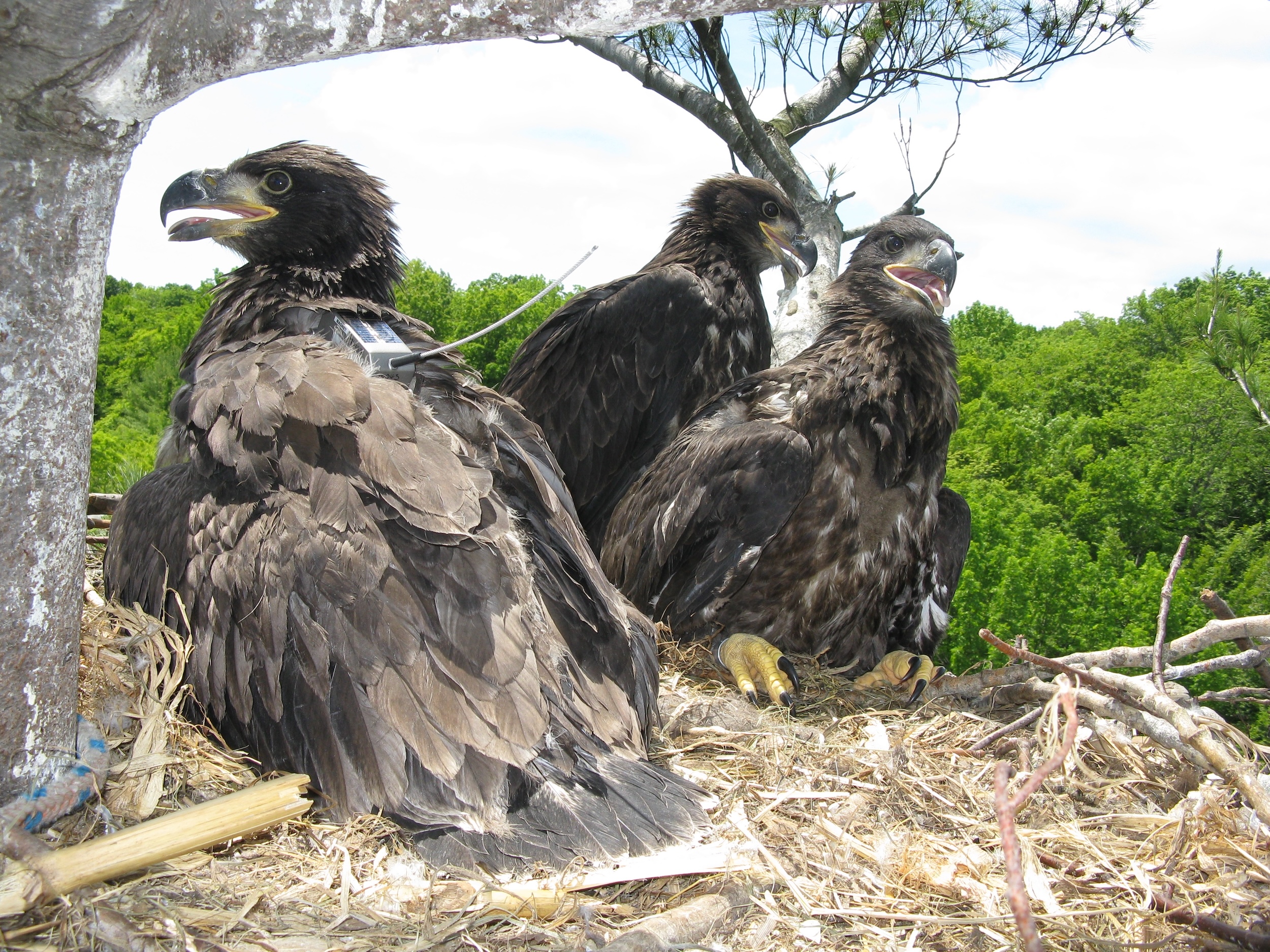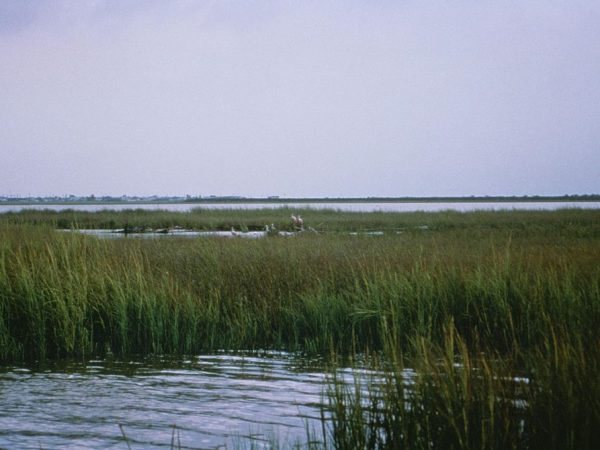
By Emma McIntosh
Growing up in a shiny Toronto-area suburb lined with concrete and puny trees, the only bald eagles Sheetal Rawal saw in the 1980s were in her imagination or on TV.
It wasn’t for lack of trying. Inspired by a particularly stirring episode of Alvin and the Chipmunks — the gang goes to Washington, D.C., to convince the president to stop a developer from bulldozing an eagle’s nest — she remembers gazing out of the car window on road trips, scanning treetops and skies for giant birds with bright white heads.
Bald eagles used to be common across most of North America, including the Great Lakes. But in the middle of the last century, populations of the bird collapsed because of widespread use of the pesticide dichlorodiphenyltrichloroethane, commonly known as DDT. In the U.S., they had nearly died out in the 1960s. There were less than 10 breeding pairs left in southern Ontario in the 1970s.
By the 1980s, when that episode of Alvin and the Chipmunks came out, their numbers had begun to bounce back elsewhere, but they were still suffering in southern Ontario. Especially around lakes Erie and Ontario, eagles were still on the species at risk list and still a rare find. Rawal never saw one, then or in the decades that followed.
So imagine Rawal’s shock last spring when a gigantic brown bird with a white head soared overhead as she walked with a friend in Peterborough, Ont. Her first-ever bald eagle.
“I was like, ‘You don’t understand how big a deal this is,’ ” Rawal said. “I don’t think I realized that they had bounced back in the way they had.”

From 2006 to 2013, keeping a close eye on southern Ontario’s bald eagles was Jody Allair’s job at Birds Canada. He caught eagles and attached tiny trackers. “The big ones, it’s sort of like folding a Labrador retriever in your lap,” he said. “They never drew blood once. The same cannot be said for banding chickadees.” Photo: supplied by Jody Allair
Bald eagles really are back in a big way. After about half a century of conservation efforts, the Ontario government made the bald eagle’s recovery official in May 2023, announcing an expert committee had deemed them no longer at risk.
The recovery of the bald eagle is a hard-fought win in a world where species are more likely to slowly wink out than experience a resurgence. It bodes well for humans, too. Bald eagles are more sensitive to contaminants than people, but the chemical that nearly wiped them out is also bad for us: though DDT was originally thought to be fine for humans in low doses, newer evidence links it to a variety of health problems, including cancer, that can persist for generations. The bald eagle resurgence in southern Ontario is a sign of the chemical gradually fading from the Great Lakes and rivers they feed in, and hopefully human bodies as well.
But bald eagles now face new threats, as do we. New contaminants, for one thing. Climate change, too: scientists expect rising temperatures to cause droughts that could threaten the fish they eat, extreme storms that could harm their nests and extreme heat that could limit their ability to reproduce. The National Audubon Society, an American non-profit, estimates just a quarter of the bald eagle’s current summer range will be liveable for the species by 2080, forcing the birds to migrate north and find new food sources and habitats to survive.
What’s happened to bald eagles is a story of recovery, but only if we actually learn from it. The decline caused by DDT was actually the second time humans nearly wiped bald eagles out. Decades before the pesticide was widely used, overhunting drastically reduced their numbers. The species is a warning of what can happen if people and governments fail to take good care of ecosystems.
Will humans make the same mistakes with the same iconic bird a third time?
“If we’re not paying attention to what we’re doing, if we’re not careful about what we’re putting into the environment, we’re just going to repeat the story over and over again,” Jody Allair of Birds Canada said.
DDT was a powerful insecticide, and a deadly poison to eagles
From time immemorial, bald eagles have been important to the people who live on this continent. Duke Redbird, an Elder from Saugeen Ojibway Nation on Lake Huron, said Anishinaabe culture reveres eagles above all birds. The animal and its feathers appear in logos for many Indigenous nations in North America, representing virtue and strength.
“They all have this great reverence for the eagle,” Redbird said.
European settlers who populated the United States adopted the bald eagle as a national symbol. But the species’ status as a cultural icon wasn’t enough to protect it. The first issue was hunting and encroachment on their habitat, which became especially bad in the early 1900s. In parts of the U.S., there were bounties to reward people who managed to kill them.
Laws aimed at protecting the raptors, including a 1916 cross-border migratory birds treaty between the U.S. and Canada, helped stop the damage. But then came DDT.
Use of the powerful pesticide took off after the Second World War. It was seen as miraculous — it killed the bugs that carried diseases like malaria and was credited for saving millions of lives. It was also used to tackle infestations of spruce budworm, a pest that harms forests. Trucks and planes used to spray it onto neighbourhoods, where kids played in the chemical fog. The scientist who discovered its insecticidal properties won a Nobel Prize.
“It was a different world,” Redbird, who was born in 1939, said. “People just didn’t feel that they had to protect the wildlife and the environment.”
By the mid-1940s, scientists started to realize the very same characteristics that made DDT a powerful pesticide also wreaked havoc on people and the environment. It spreads easily, gets into soils, water and living tissue and persists for decades. It poisoned the nervous systems of birds, which would die off en masse close to sites where it was sprayed.
Over time, it also accumulated in the bodies of predators at the top of the food chain, like eagles, causing the birds to lay thin-shelled eggs that would crack when parents tried to incubate them. Populations of eagles, and other birds like peregrine falcons and cormorants, plummeted. By 1980, there were just three nesting bald eagle pairs in southern Ontario, all scattered on the north shore of Lake Erie.
“None of them could breed,” Allair said. He led Birds Canada’s bald eagle monitoring program when it was running. “It was heartbreaking. … They were just loaded with DDT. They just kept laying eggs and the eggs were breaking.”

Birds Canada’s monitoring program involved tracking southern Ontario bald eagles, including outfitting these juveniles with satellite transmitters that look like little backpacks. Photo: Jody Allair / Birds Canada
In the intervening years, public awareness started to rise, mostly because of American biologist Rachel Carson. In her 1962 book, Silent Spring, she documented how pesticides were accumulating in the ecosystem and in people. She also offered grim predictions of what would happen if we didn’t stop using them.
“It was a spring without voices,” she wrote, describing a fictional town in the future. “On the mornings that had once throbbed with the dawn chorus of robins, catbirds, doves, jays, wrens and scores of other bird voices there was now no sound; only silence lay over the fields and woods and marsh.”
Silent Spring was a bestseller. Despite backlash from the chemical industry, which said Carson was hysterical and alarmist, the book sparked massive public concern about widespread use of pesticides — spurring the modern environmental movement. It took another decade for politicians to start making change. Canada phased out most uses of DDT in the 1970s and banned it entirely after 1990.
Once again, bald eagles began to bounce back from the edge of extinction. Their progress was slowest around the densely populated and highly polluted lower Great Lakes: in other words, southern Ontario.
To help the birds recover there, governments and experts had to be particularly hands-on, co-ordinating field studies and monitoring programs to find bald eagles and protect them from human disturbances. They needed to keep adult bald eagles alive long enough for DDT to degrade in the ecosystem, which would eventually allow the species to reproduce properly again.
From 2006 to 2013, keeping a close eye on the region’s bald eagles was Allair’s job. He banded bald eagles in southern Ontario, catching them and attaching tiny trackers that would allow scientists to see their movements. “They’re so wonderful in the hand, surprisingly,” he said. “The big ones, it’s sort of like folding a Labrador retriever in your lap. The most well-behaved Labrador retriever. They never drew blood once. The same cannot be said for banding chickadees.”
Some of the birds got satellite transmitters that look like little backpacks. Allair knew them by name. Volunteers on the ground were also paying attention, keeping a watchful eye out.
Once, Allair found an injured adult eagle in Port Dover, Ont., by Lake Erie. She had damaged wings that looked like they’d been bitten. “She was so weak,” he said. She didn’t seem like she had much time. So he hopped in the car and drove her to the nearest animal hospital equipped to take care of her, more than an hour away.
“I’m not sure of the legality of what I did, but I had her in the seat,” Allair said. When they arrived, he remembers people gawking as he speed-walked with her through the parking lot. “I was just holding her like a football … everyone in there just had these small dogs and stuff, it was so funny.” The bird recovered and was released back into the wild. For years afterwards, she’d circle over Allair when he was around Port Dover. He could tell it was her because she never grew feathers back in the spot where she’d been bitten.
“It’s really nice to have those wins because the list of losses and non-wins with species and habitat loss is even bigger,” Allair said.
Bald eagles are a great recovery story, but only if we learn from it
As DDT was phased out, more healthy eggs hatched and more chicks survived until adulthood. More eagles have returned to the Great Lakes. They even began to trickle into cities. Just this year, a pair of eagles nested in Toronto, the first known duo in the city’s modern history. Two eaglets hatched there this spring.
Bringing bald eagles back from the brink required a long-term, multi-part strategy. First, a lot of people worked really hard to raise awareness, push politicians to act and steward ecosystems to make them livable for the birds. Second, governments outlawed DDT, despite strong resistance from industry.
The success of this approach could help people and governments around the world as they try to slash carbon pollution to mitigate climate change while facing a blitz of lobbying from industry.
“It’s a great example of a whole bunch of people who worked together,” Allair said. “If governments are listening to the experts and adopt progressive policies, we can stop the decline and in fact, even help create a really successful recovery for birds. I think that’s a lesson. I worry about people forgetting.”
Of course, climate change offers a more complex set of problems, with a larger set of causes and a wider spread of harm. It’s not just eagles: wild bird populations have declined by about a third across North America over the last 50 years, according to a landmark 2019 study. The changes even affect common backyard birds like robins and blue jays. Spring may not be silent, but it’s getting quieter. And just as with DDT, the factors contributing to that — pollution, habitat loss, rising global temperatures — have serious implications for human health too.
The core piece that’s missing, the thing decision makers really must prioritize, is human and ecosystem health, Redbird said. The return of eagles to Toronto’s waterfront shows what’s possible.
“There’s a lot of mythology associated with eagles in so many ways,” he said. “It’s an important symbol.”
Catch more news at Great Lakes Now:
Bald eagle return exceeds expectations
Featured image: A juvenile bald eagle near Lake Huron in 2022. (Photo: Ramona Leitao / The Narwhal)




